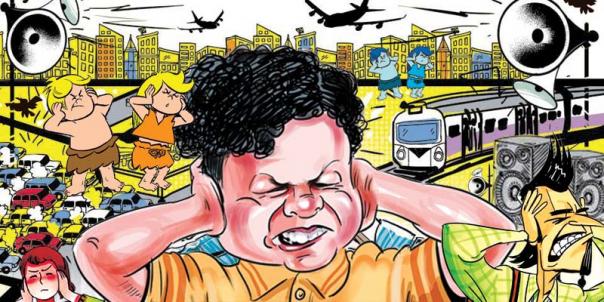
As the season of firecrackers and loudspeakers rolls in, here is Fresh evidence from WHO about the harmful effects of noise pollution. In a survey it released recently, WHO identified 5 broad sources of noise pollution.
India introduced its Noise Pollution Rules in 2000, but the WHO guidelines are based on newer research. A comparison shows India’s permissible thresholds are much higher.
How Noise Pollution is Classified?
WHO identifies five sources:
- Road traffic
- Railways
- Aircraft
- Wind turbines
- Leisure
India frames noise pollution rules for zones:
- Industrial
- Commercial
- Residential
- Silent
Road Traffic:
WHO Guidelines:
- Day time limit: 53 dB
- Night time limit: 45 dB *
* Noise higher than this level affects sleep.
India has a higher threshold:
- Motorbikes, scooters and 3-wheelers: 80 dB
- Passenger cars and commercial vehicles: 82-85 dB
- Larger vehicles: 89-91 dB
Railway:
WHO Guidelines:
- Day time limit: 54 dB
- Night time limit: 44 dB
India says people, especially in areas that have railway tracks, need protection from rail noise but there are no specifics.
Aircraft:
WHO Guidelines:
- Day time limit: 54 dB
- Night time limit: 44 dB
India lays down safeguards, but does not cap safe decibel levels.
Wind turbine:
WHO Guidelines:
Limit: below 45 dB (no recommendation for night noise exposure)
India says people, especially in areas that have railway tracks, need protection from rail noise but there are no specifics.
Leisure:
WHO Guidelines:
WHO says yearly average of all leisure noise sources should be 70 dB
Indian Rules says:
- Loudspeakers cannot be used between 10 pm and 6 am, noise level should not exceed the standard for the zone by more than 11 dB.
- Firecrackers with noise of more than 90 dB at 5 m distance from the site of bursting are banned.
India’s Ceiling for Industrial or commercial areas is higher than WHO guidelines
Industrial area
- Day time limit: 75 dB
- Night time limit: 70 dB
Commercial area
- Day time limit: 65 dB
- Night time limit: 55 dB
Residential area
- Day time limit: 55 dB
- Night time limit: 45 dB
Silence zone
- Day time limit: 50 dB
- Night time limit: 40 dB
Effect on Health:
- WHO says noise pollution causes sleep disturbance, hearing problems, heart disease and leads to poorer work performance.
- Less than 30 dB noise in bedrooms at night for good quality sleep and less than 35 dB in classrooms.
Remedies:
- India can make rapid progress in cutting noise pollution if we start with our roads.
- No honking campaigns are organizing by various NGOs or institutions.
Matter Referenced: Times of India, Ahmedabad, Friday, 19th October, 2018.
By: Dr. Bhawana Asnani.
Happy to see Reviews, Additions, Suggestions and Comments, further.

Leave a Reply
You must be logged in to post a comment.